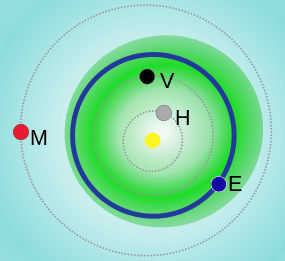(192642) 1999 RD32
|
| |
| Discovery[1] | |
|---|---|
| Discovered by | LINEAR (704) |
| Discovery date | 8 September 1999 |
| Designations | |
| MPC designation | (192642) 1999 RD32 |
Apollo  NEO, PHA[2] | |
| Orbital characteristics[2] | |
| Epoch 13 January 2016 (JD 2457400.5) | |
| Uncertainty parameter 0 | |
| Observation arc | 7702 days (21.09 yr) |
| Aphelion | 4.6785 AU (699.89 Gm) (Q) |
| Perihelion | 0.60926 AU (91.144 Gm) (q) |
| 2.6439 AU (395.52 Gm) (a) | |
| Eccentricity | 0.76956 (e) |
| 4.30 yr (1570.2 d) | |
| 311.50° (M) | |
| 0° 13m 45.372s / day (n) | |
| Inclination | 6.7925° (i) |
| 310.06° (Ω) | |
| 299.87° (ω) | |
| Earth MOID | 0.0497973 AU (7.44957 Gm) |
| Jupiter MOID | 0.669115 AU (100.0982 Gm) |
| Physical characteristics | |
| Dimensions | ~5 kilometers (3 mi)[3] |
| 17.08 h (0.712 d) | |
Sidereal rotation period | 17.08 hr[2][3][4] |
| ~0.04[3] | |
| 16.3[2] | |
|
| |
(192642) 1999 RD32, provisionally known as 1999 RD32, is a near-Earth asteroid and potentially hazardous object.[2] It was discovered on 8 September 1999 by Lincoln Near-Earth Asteroid Research (LINEAR) at an apparent magnitude of 18 using a 1.0-meter (39 in) reflecting telescope.[1]
With two precovery images from January 1995,[5] the asteroid has a very well determined orbit with an observation arc of 17 years.[2] It is known that 1999 RD32 passed 0.0093 AU (1,390,000 km; 860,000 mi) from Earth on 27 August 1969.[6] During the 1969 close approach the asteroid reached about apparent magnitude 8.8.[7] The similarly-sized 4179 Toutatis also reached that brightness in September 2004. 1999 RD32 passed less than 0.007 AU (1,000,000 km; 650,000 mi) from asteroid 29 Amphitrite on 17 January 1939.[2]
Arecibo radar observations on 5–6 March 2012 showed that 1999 RD32 is approximately 5 kilometers (3 mi) in diameter[3] and has an albedo of only a few percent.[3] The two visible lobes suggest that 1999 RD32 is a tight binary asteroid or contact binary.[3] About 10–15% of near-Earth asteroids larger than 200 meters are expected to be contact binary asteroids with two lobes in mutual contact.[8]
| Date | Distance from Earth |
|---|---|
| 1969-08-27 | 0.0093 AU (1,390,000 km; 860,000 mi) |
| 2012-03-14 | 0.1487 AU (22,250,000 km; 13,820,000 mi) |
| 2042-03-11 | 0.1428 AU (21,360,000 km; 13,270,000 mi) |
| 2046-09-04 | 0.1071 AU (16,020,000 km; 9,960,000 mi) |
References
- 1 2 "MPEC 1999-R32 : 1999 RD32". IAU Minor Planet Center. 1999-09-11. Retrieved 2014-02-28. (J99R32D)
- 1 2 3 4 5 6 7 "JPL Small-Body Database Browser: 192642 (1999 RD32)" (2012-11-03 last obs and observation arc=17.8 years). Jet Propulsion Laboratory. Retrieved 7 April 2016.
- 1 2 3 4 5 6 "(192642) 1999 RD32 Goldstone Radar Observations Planning". NASA/JPL Asteroid Radar Research. 2012-03-12. Retrieved 2014-02-28.
- ↑ Warner, Brian D.; Megna, Ralph (2012). "Lightcurve Analysis of NEA (192642) 1999 RD32". The Minor Planet Bulletin. 39 (3): 154. Bibcode:2012MPBu...39..154W.
- ↑ "(192642) = 1999 RD32 Orbit" (2012-11-03 (arc=6515 days)). Minor Planet Center. Retrieved 2014-02-28.
- 1 2 "JPL Close-Approach Data: 192642 (1999 RD32)" (2012-11-03 last obs and observation arc=17.8 years). Retrieved 2014-02-28.
- ↑ "1999RD32 Ephemerides for 25 August 1969 through 31 August 1969". NEODyS (Near Earth Objects – Dynamic Site). Retrieved 2014-02-28.
- ↑ Michael Busch (2012-03-12). "Near-Earth Asteroids and Radar Speckle Tracking" (PDF). Retrieved 2014-02-28.
External links
- Orbital simulation from JPL (Java) / Ephemeris
- Arecibo images from 2012
- (192642) 1999 RD32 at the JPL Small-Body Database
